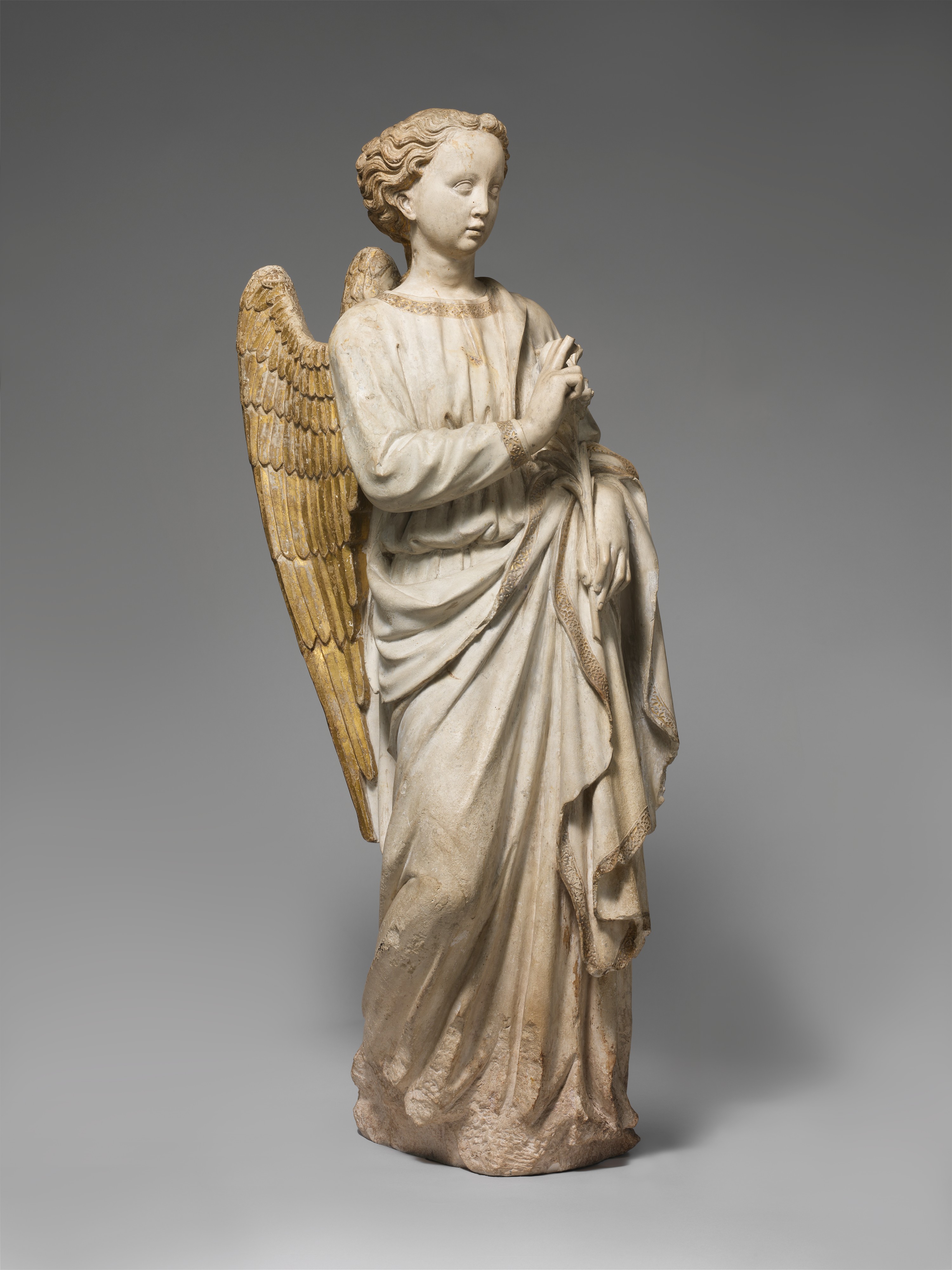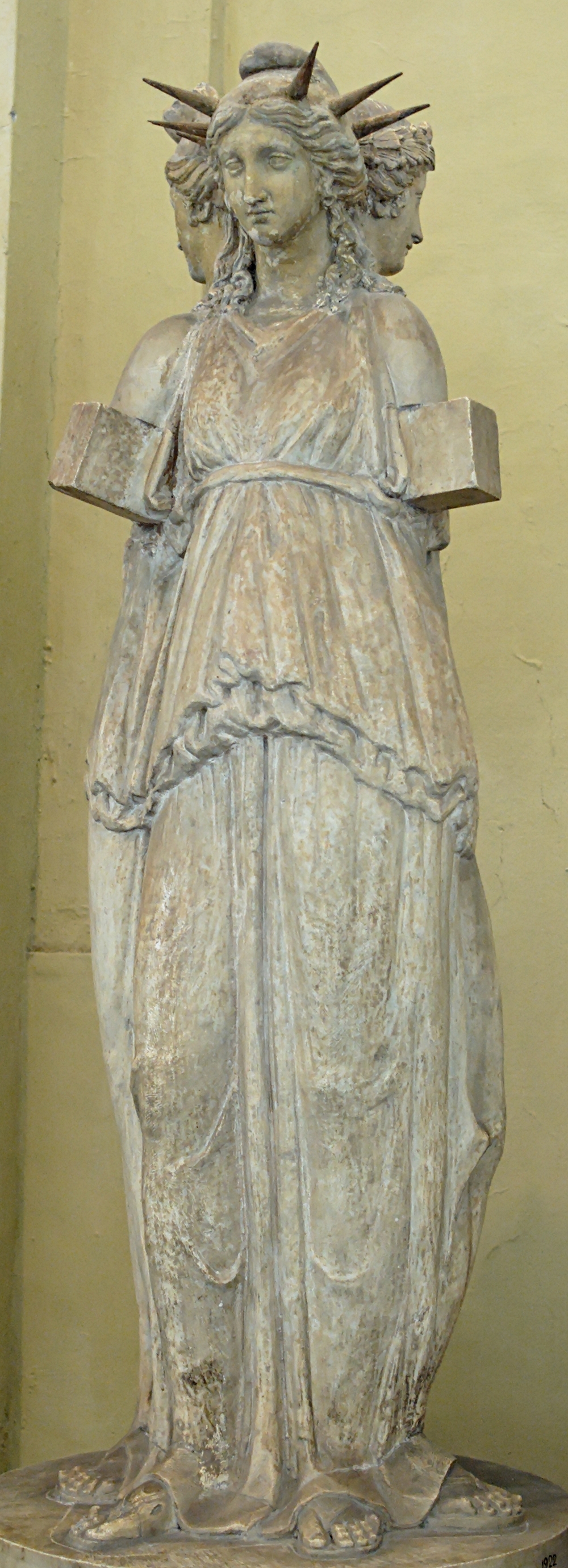|
Enêpsigos
Enêpsigos (Enêpsigos) is a fallen angel mentioned in the Testament of Solomon who takes three forms as her abode is the moon, and at times is conjured as Kronos. In it, she is said to have been bound by triple-link chains and to have given a prophecy to King Solomon who did not believe the prophecy and then proceeded to rebound her in chains, this time, unbreakable. Entity Enêpsigos is an angel mentioned in the Testament of Solomon 64: 1-7 where King Solomon asked Enêpsigos which angel she was frustrated by. However, Enêpsigos refers to herself as a goddess, replying back, "I undergo changes, like the goddess I am called". Enêpsigos is also linked to "ancient forms of the Triple Goddesses" and is distinguished as being able to shape shift into a goddess as one of her forms. Enêpsigos' three forms are in correlation with the moon's waxing, full, and new phases. Enêpsigos' most cited form is a woman with two heads. She can also take the form of the Greek Titan Kronos. Ther ... [...More Info...] [...Related Items...] OR: [Wikipedia] [Google] [Baidu] |
Testament Of Solomon
The Testament of Solomon is a pseudepigraphical composite text ascribed to King Solomon but not regarded as canonical scripture by Jews or Christian groups. It was written in the Greek language, based on precedents dating back to the early 1st millennium AD, but was likely not completed in any meaningful textual sense until sometime in the Middle Ages. In its most noteworthy recensions, the text describes how Solomon was enabled to build his temple by commanding demons by means of a magical ring that was entrusted to him by the archangel Michael. Dating and authorship Scholarly opinion on when the Testament of Solomon was written varies widely. Suggested dates for its composition range between the end of the 1st century AD and the High Middle Ages. Also disputed is whether it had a Christian or Jewish origin. Mid-twentieth century scholarship tended to agree that much of its content "reflects the first-century Judaism in Israel" and includes material much earlier than its com ... [...More Info...] [...Related Items...] OR: [Wikipedia] [Google] [Baidu] |
Fallen Angel
Fallen angels are angels who were expelled from Heaven. The literal term "fallen angel" does not appear in any Abrahamic religions, Abrahamic religious texts, but is used to describe angels cast out of heaven. Such angels are often described as corrupting humanity by teaching forbidden knowledge or by tempting them into sin. Common motifs for their expulsion are lust, pride, envy, or an attempt to usurp divinity. The earliest appearance of the concept of fallen angels may be found in Canaanite religion, Canaanite beliefs about the ''bənē hāʾĔlōhīm'' ("sons of God"), expelled from the Pantheon (religion), divine court. ''Hêlêl ben Šāḥar'' is thrown down from heaven for claiming equality with ''ʻElyōn''. Such stories were later collected in the Old Testament and appear in Pseudepigrapha, pseudepigraphic Apocalyptic literature, Jewish literature. The concept of fallen angels derives from the assumption that the "sons of God" () mentioned in Primeval history, Genesi ... [...More Info...] [...Related Items...] OR: [Wikipedia] [Google] [Baidu] |
Cronus
In ancient Greek religion and Greek mythology, mythology, Cronus, Cronos, or Kronos ( or ; ) was the leader and youngest of the Titans, the children of Gaia (Earth) and Uranus (mythology), Uranus (Sky). He overthrew his father and ruled during the mythological Golden Age until he was overthrown by his son Zeus and imprisoned in Tartarus. According to Plato, however, the deities Phorcys, Cronus, and Rhea (mythology), Rhea were the eldest children of Oceanus and Tethys (mythology), Tethys. Cronus was usually depicted with a harpe, scythe, or sickle, which was the instrument he used to castrate and depose Uranus, his father. In Athens, on the twelfth day of the Attic month of Attic calendar, Hekatombaion, a festival called Kronia was held in honour of Cronus to celebrate the harvest, suggesting that, as a result of his association with the virtuous Golden Age, Cronus continued to preside as a List of agricultural gods, patron of the harvest. Cronus was also identified in classi ... [...More Info...] [...Related Items...] OR: [Wikipedia] [Google] [Baidu] |
King Solomon
King is a royal title given to a male monarch. A king is an absolute monarch if he holds unrestricted governmental power or exercises full sovereignty over a nation. Conversely, he is a constitutional monarch if his power is restrained by fixed laws. Kings are hereditary monarchs when they inherit power by birthright and elective monarchs when chosen to ascend the throne. *In the context of prehistory, antiquity and contemporary indigenous peoples, the title may refer to tribal kingship. Germanic kingship is cognate with Indo-European traditions of tribal rulership (cf. Indic ''rājan'', Gothic ''reiks'', and Old Irish '' rí'', etc.). *In the context of classical antiquity, king may translate in Latin as '' rex'' and in Greek as ''archon'' or ''basileus''. *In classical European feudalism, the title of ''king'' as the ruler of a ''kingdom'' is understood to be the highest rank in the feudal order, potentially subject, at least nominally, only to an emperor (harking back ... [...More Info...] [...Related Items...] OR: [Wikipedia] [Google] [Baidu] |
Angel
An angel is a spiritual (without a physical body), heavenly, or supernatural being, usually humanoid with bird-like wings, often depicted as a messenger or intermediary between God (the transcendent) and humanity (the profane) in various traditions like the Abrahamic religions. Other roles include protectors and guides for humans, such as guardian angels and servants of God. In Western belief-systems the term is often used to distinguish benevolent from malevolent intermediary beings. Emphasizing the distance between God and mankind, revelation-based belief-systems require angels to bridge the gap between the earthly and the transcendent realm. Angels play a lesser role in monistic belief-systems, since the gap is non-existent. However, angelic beings might be conceived as aid to achieve a proper relationship with the divine. Abrahamic religions describe angelic hierarchies, which vary by religion and sect. Some angels have specific names (such as Gabriel or Mich ... [...More Info...] [...Related Items...] OR: [Wikipedia] [Google] [Baidu] |
Hekate
Hecate ( ; ) is a goddess in ancient Greek religion and mythology, most often shown holding a pair of torches, a key, or snakes, or accompanied by dogs, and in later periods depicted as three-formed or triple-bodied. She is variously associated with crossroads, night, light, magic, witchcraft, drugs, and the Moon.Seyffert, s.vHecate/ref>d'Este, Sorita & Rankine, David, Hekate Liminal Rites, Avalonia, 2009. Her earliest appearance in literature was in Hesiod's ''Theogony'' in the 8th century BCE as a goddess of great honour with domains in sky, earth, and sea. She had popular followings amongst the witches of Thessaly, and an important sanctuary among the Carians of Asia Minor in Lagina.Burkert, p. 171. The earliest evidence for Hecate's cult comes from Selinunte, in Sicily. Hecate was one of several deities worshipped in ancient Athens as a protector of the ''oikos'' (household), alongside Zeus, Hestia, Hermes, and Apollo. In the post-Christian writings of the Chaldean Oracles ... [...More Info...] [...Related Items...] OR: [Wikipedia] [Google] [Baidu] |
Ashmedai
Asmodeus (; , ''Asmodaios'') or Ashmedai (; ; ; see below for other variations) is a king of demons in the legends of Solomon and the constructing of Solomon's Temple."Asmodeus" in '' The New Encyclopædia Britannica''. Chicago: Encyclopædia Britannica Inc., 15th edn., 1992, Vol. 1, p. 635. He is featured variously in Talmudic stories where he is the king of the ''shedim''. The Quran refers to a "puppet" in the Story of Solomon in Surah Ṣād verses 30-40, which is according to the '' mufassirūn'' (authorized exegetes of the Quran) referring to the demon-king Asmodeus (Sakhr). In Christianity, Asmodeus is mostly known from the deuterocanonical Book of Tobit. He is the primary antagonist and disrupts the marriages of Sarah. Peter Binsfeld classifies Asmodeus as the "demon of lust". Etymology The name ''Asmodai'' is believed to derive from the Avestan ''*aēšma-daēva'' (𐬀𐬉𐬴𐬨𐬀𐬛𐬀𐬉𐬎𐬎𐬀*, *''aēṣ̌madaēuua''), where ''aēšma'' means "wra ... [...More Info...] [...Related Items...] OR: [Wikipedia] [Google] [Baidu] |
Demons In Judaism
A demon is a malevolent supernatural entity. Historically, belief in demons, or stories about demons, occurs in folklore, mythology, religion, occultism, and literature; these beliefs are reflected in media including fiction, comics, film, television, and video games. Belief in demons probably goes back to the Paleolithic age, stemming from humanity's fear of the unknown, the strange and the horrific.. In ancient Near Eastern religions and in the Abrahamic religions, including early Judaism and ancient-medieval Christian demonology, a demon is considered a harmful spiritual entity that may cause demonic possession, calling for an exorcism. Large portions of Jewish demonology, a key influence on Christianity and Islam, originated from a later form of Zoroastrianism, and was transferred to Judaism during the Persian era. Demons may or may not be considered to be devils: minions of the Devil. In many traditions, demons are independent operators, with different demons causing ... [...More Info...] [...Related Items...] OR: [Wikipedia] [Google] [Baidu] |
Hecate
Hecate ( ; ) is a goddess in ancient Greek religion and mythology, most often shown holding a pair of torches, a key, or snakes, or accompanied by dogs, and in later periods depicted as three-formed or triple-bodied. She is variously associated with crossroads, night, light, magic, witchcraft, drugs, and the Moon.Seyffert, s.vHecate/ref>d'Este, Sorita & Rankine, David, Hekate Liminal Rites, Avalonia, 2009. Her earliest appearance in literature was in Hesiod's '' Theogony'' in the 8th century BCE as a goddess of great honour with domains in sky, earth, and sea. She had popular followings amongst the witches of Thessaly, and an important sanctuary among the Carians of Asia Minor in Lagina.Burkert, p. 171. The earliest evidence for Hecate's cult comes from Selinunte, in Sicily. Hecate was one of several deities worshipped in ancient Athens as a protector of the '' oikos'' (household), alongside Zeus, Hestia, Hermes, and Apollo. In the post-Christian writings of the Chalde ... [...More Info...] [...Related Items...] OR: [Wikipedia] [Google] [Baidu] |







